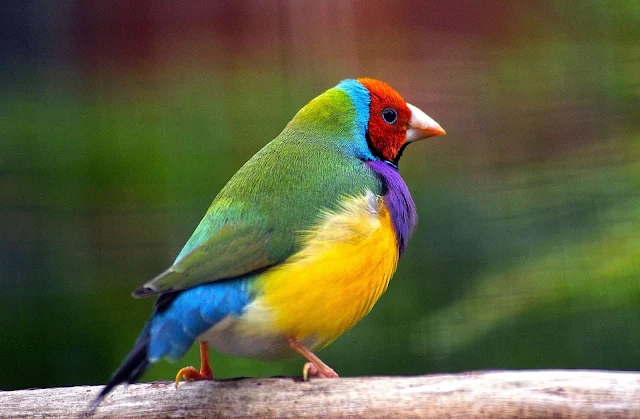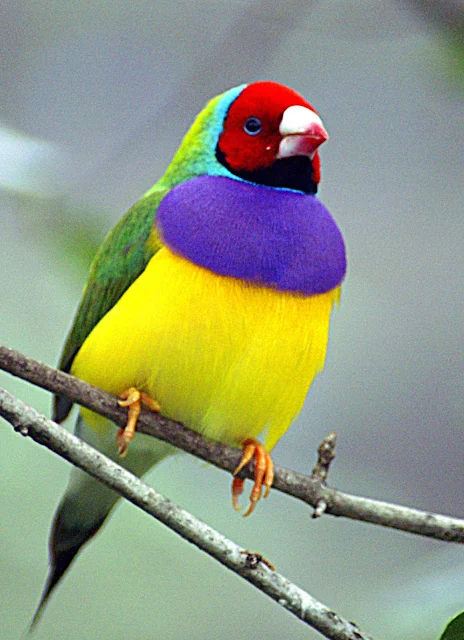The vivid and multicolored plumage of the Gouldian Finch, sometimes called the Seven-Color Finch, gave it its name. It should come as no surprise that many homes keep this particular kind of bird as a pet. The Gouldian Finch, however, is now in danger of going extinct in the wild due to decades of decline.
Here are three interesting details regarding the Gouldian Finch.
Gouldian Finches often have three distinct colored heads. 20% to 30% have red heads, whereas 70% to 80% have black faces. The Gouldian Finch with the yellow head is the most uncommon; just 3,000 of these birds have this distinguishing trait.
The preferred temperature range for this tropical bird species is hotter than 80°F (27°C).
Males have gained brighter plumage and the capacity to sing melodiously to entice females during the breeding season. Intense colouring and song may operate as signs of power and well-being to entice female birds.
The residence of Gouldian Finches.
Primarily found in Australia's northern areas, this bird species. The Northern Territory, the Kimberley area of Western Australia, and occasionally farther east into Queensland are the only places where it is still present. With access to enough Smooth-barked Apple trees and adjacent water sources, Gouldian Finches like to live in grasslands and open plains.
Personality Qualities
Outside of the mating season, gouldian finches create enormous flocks with hundreds of other birds. Calls, chirps, chatters, and songs can all be produced by males and females to communicate with one another.
The Smooth-barked Apple trees' thick foliage shields them from the glaring sun and predators throughout the day, when they are most active.
What food consume Gouldian Finches?
Their large, strong beaks, like those of many other finch species, are ideally suited for breaking open and eating seeds. They may eat as many seeds each day as 35% of their body weight.
Process of Gouldian Finches Breeding
Male finches exhibit lively wooing activities by puffing up their chests, fluffing their feathers, and bobbing their heads during the mating season, which normally lasts from December to April. These displays cause females to preen their beaks in response.
The female begins to lay one egg after mating, and continues to do so until the clutch size reaches 4 to 8 eggs. When it comes to caring for the nestlings and incubating the eggs, both the male and female perform crucial responsibilities. The nestlings hatch after about two weeks of incubation. The parents can recognize them in the dark because they are initially without feathers and have a blue mark in the corner of their beaks.
By the time they are 3 to 4 weeks old, the fledglings have grown all of their feathers. Both males and females exhibit duller grayish-green plumage at this stage. Finches don't reveal their gender until they are 6 to 8 weeks old.
In captivity, Gouldian Finches often survive for eight years, although wild birds typically live for less time.
The colors of male and female Gouldian Finches are very similar. However, identifying their gender from exterior color observation is rather simple:
Compared to females, males often have brighter, more dramatic plumage with distinct color patches on their bodies. When they are adults, males also tend to sing more and have larger tail feathers in the middle of their tails.
Compared to male Gouldian Finches, females have duller and lighter plumage. The beaks of female Gouldian Finches gradually become black throughout the mating season.
Q&A on Gouldian Finches
How long does the Gouldian Finches' incubation period last?
For this species, the incubation period lasts on average two weeks.
When do young Gouldian Finch leave their nest?
After hatching, the chicks will depart the nest in three to four weeks. They don't actually become autonomous until they are 40 days old.
Can one keep Gouldian Finches as pets?
Gouldian Finches are quite popular as pets because of their colorful plumage, endearing personality, and very simple maintenance needs. They are frequently regarded as jovial and excellent company. Normal Gouldian Finch costs are often not excessive, however they could be for unusual color variations.
How loud are Gouldian Finches?
Both male and female Gouldian Finches make pleasing, melodious noises that aren't overly loud or intrusive.
Population of the Gouldian Finch today
Australia used to be home to millions of Gouldian Finches. There are currently just around 2,500 individuals left in the wild.
Gouldian Finches have experienced a number of problems throughout the years, including habitat loss (particularly due to wildfires), predators, illnesses, and parasites (like mites).
They have also been targets of human hunts due to their vibrant and distinctive plumage. A sizable portion of them have been taken by humans for domestic use.
In the 1980s, Australia outlawed the capture and export of Gouldian Finches. They are also recognized as an endangered species by the Australian government.






